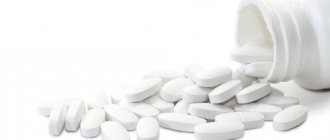Chemical properties
Pharmacological group of Izadrina – catecholamines , beta-adrenergic stimulants . The substance was obtained in 1938 as a derivative of adrenaline . In the chemical structure of the molecule, the bimethyl radical of the amino group of adrenaline was replaced by isopropyl radical . Only in 1948, when the division of adrenergic receptors into alpha and beta was discovered, it became clear that isopropylnorepinephrine belongs to the group of beta adrenergic stimulants.
The product was synthesized in the form of a white crystalline powder, which is highly soluble in water. An aqueous solution of Izadrina has a subtle greenish tint. The molecular weight of the compound is 211.3 grams per mole. The substance is available in the form of a solution and powder for inhalation or tablets for oral administration.
Pharmacodynamics and pharmacokinetics
This compound activates the enzyme adenylate cyclase and stimulates the accumulation of cAMP in cells, which in turn affects the protein kinase . Thus, myosin can no longer interact with actin , smooth muscle does not contract, and the bronchi relax.
When using therapeutic dosages, the drug non-selectively stimulates beta-adrenergic receptors. This leads to an increase in heart rate, an increase in cardiac output, increased contractions of the heart muscle and a decrease in the filling of the ventricles of the heart. Blood pressure decreases and the muscle's need for oxygen increases.
The substance also has the ability to reduce renal blood flow, dilate the vessels of the peritoneum, mucous membrane and skin, and relax the muscles of the uterus. The medicine blocks the work of mast cells, they can no longer produce leukotrienes and histamine , which contribute to the occurrence of inflammation and bronchospasm .
When sublingually , the substance is completely absorbed into the systemic circulation. Metabolism occurs with the participation of the enzyme phenolsulfotransferase and COMT . Bioavailability, unlike inhalation of the drug, is greatly reduced. The half-life of the drug is 120 minutes.
Izadrin
Name: Isadrin (Isadrinum) Pharmacological action: The pharmacological and therapeutic effect of Isadrinum is explained by its stimulating effect on beta-adrenergic receptors. The action of isadrin extends simultaneously to 6era- and beta2-adrenergic receptors, so the effect on the bronchi, cardiovascular system and other organs equipped with beta-adrenergic receptors is not selective. During heart blocks, the effect of isadrin is associated with an improvement in conductivity due to its effect on the sympathetic innervation of the heart, with an increase in the excitability and contractile function of the myocardium (heart muscle). A similar effect is exerted by various sympathomimetic substances, including norepinephrine, adrenaline, ephedrine; however, these drugs cause increased blood pressure, angina pain (pain in the heart), increased excitability of ectopic foci (displaced rhythm sources) and other side effects, which limits the possibility of their widespread use in atrioventricular block (impaired conduction of excitation through the conduction system of the heart). Isadrin is more convenient for this purpose, since it does not increase blood pressure and is less capable of causing ventricular fibrillation (chaotic contractions of the heart muscle).
Indications for use: Izadrin is used in the treatment of patients with atrioventricular conduction disorders, to relieve atrioventricular block and prevent attacks in Adams-Stokes-Morgagni syndrome (loss of consciousness with a sharp drop in pressure in certain cardiac arrhythmias). Isadrin is also used in some forms of cardiogenic shock (normovolemic /without changes in circulating blood volume/, with reduced output and high peripheral resistance).
Method of administration: Administered intravenously in a 5% glucose solution at a dose of 0.5-5 mcg (0.0005-0.005 mg) per minute.
Side effects: When using isadrin (especially in cardiological practice), it should be taken into account that it causes tachycardia (rapid heartbeat), can activate ectopic foci, cause extrasystoles (heart rhythm disturbances) with the risk of ventricular fibrillation. You should also consider the possibility of nausea and tremor (shaking) of the hands. dry mouth. Caution should be exercised when prescribing to patients with angina pectoris and thyrotoxicosis (thyroid disease).
Release form: 0.5% and 1% solutions in bottles of 25 and 100 ml; tablets containing 0.005 g of the drug.
Storage conditions: List B. In a dry, cool place, protected from light.
Synonyms: Isoprenaline hydrochloride, Isoproterenol, Isuprel, Novodrin, Euspiran, Aleudrin, Aludrin, Antasmin, Bronchodilatin, Izodrenal, Isonorin, Isopropylarterenol, Isorenin, Neodrenal, Neoepinephrine, Norizodrine.
Attention! The description of the drug “ Isadrin ” on this page is a simplified and expanded version of the official instructions for use. Before purchasing or using the drug, you should consult your doctor and read the instructions approved by the manufacturer. Information about the drug is provided for informational purposes only and should not be used as a guide to self-medication. Only a doctor can decide to prescribe the drug, as well as determine the dose and methods of its use.
Indications for use
Isoprenaline hydrochloride is prescribed:
- to relieve attacks of bronchial asthma ;
- with pneumosclerosis ;
- as a prophylactic for bronchial asthma ;
- for chronic bronchitis with broncho-obstructive syndrome ;
- patients with and 3rd degree AV block ;
- for the prevention of Morgagni-Adams-Stokes attacks ;
- with cardiogenic shock without changes in blood volume .
Izadrin, instructions for use (Method and dosage)
The medicine is used in the form of a 0.5% or 1% aqueous solution for inhalation or powder. The procedure is carried out using a special inhaler. When injecting the medicine, 0.1-0.2 ml of the drug is released. Inhalation can be repeated up to 3 times a day.
An attack of bronchial asthma is relieved by inhaling one dose of the drug. After 5 minutes the procedure can be repeated. Further, the medicine can be used only after 3-4 hours. The maximum daily dosage is 12 doses.
Isoprenaline, instructions for use of tablets
One tablet of Izadrina contains 5 mg of active substance. Half or a whole tablet is placed under the tongue and slowly dissolved. You can take 3 to 4 tablets per day.
The duration of treatment is determined by the attending physician. Most often, the drug is used when there is an urgent need.
ISADRIN (Isadrinum)
Home Medical Encyclopedia Medicines in alphabet I
Synonyms:
Isoprenaline hydrochloride, Isoproterenol, Isuprel, Novodrin, Euspiran, Aleudrin, Aludrin, Antasmin, Bronchodilatin, Izodrenal, Isonorin, Isopropylarterenol, Isorenin, Neodrenal, Neoepinephrine, Norizodrine.
Pharmachologic effect.
The pharmacological and therapeutic effect of isadrin is explained by its stimulating effect on beta-adrenergic receptors. The action of isadrin extends simultaneously to 6era- and beta2-adrenergic receptors, so the effect on the bronchi, cardiovascular system and other organs equipped with beta-adrenergic receptors is not selective.
During heart blocks, the effect of isadrin is associated with an improvement in conductivity due to its effect on the sympathetic innervation of the heart, with an increase in the excitability and contractile function of the myocardium (heart muscle). A similar effect is exerted by various sympathomimetic substances, including norepinephrine, adrenaline, ephedrine; however, these drugs cause increased blood pressure, angina pain (pain in the heart), increased excitability of ectopic foci (displaced rhythm sources) and other side effects, which limits the possibility of their widespread use in atrioventricular block (impaired conduction of excitation through the conduction system of the heart). Izadrin
more convenient for this purpose, since it does not increase blood pressure and is less capable of causing ventricular fibrillation (chaotic contractions of the heart muscle).
Indications for use.
Isadrin is used in the treatment of patients with atrioventricular conduction disorders, to relieve atrioventricular block and prevent attacks in Adams-Stokes-Morgagni syndrome (loss of consciousness with a sharp drop in pressure due to certain heart rhythm disturbances).
Isadrin is also used in some forms of cardiogenic shock (normovolemic /without changes in circulating blood volume/, with reduced output and high peripheral resistance).
Method of administration and dose.
Administered intravenously in a 5% glucose solution at a dose of 0.5-5 mcg (0.0005-0.005 mg) per minute.
Side effect.
When using isadrin (especially in cardiological practice), it should be taken into account that it causes tachycardia (rapid heartbeat), can activate ectopic foci, cause extrasystoles (heart rhythm disturbances) with the risk of ventricular fibrillation. You should also consider the possibility of nausea and hand tremor (shaking). dry mouth. Caution should be exercised when prescribing to patients with angina pectoris and thyrotoxicosis (thyroid disease).
Contraindications.
Release form.
0.5% and 1% solutions in bottles of 25 and 100 ml; tablets containing 0.005 g of the drug.
Storage conditions.
List B. In a dry, cool place, protected from light.
| print version | This information is not a guide to self-treatment. A doctor's consultation is required. |
Interaction
The combination of the drug with amiodarone reduces the effectiveness of the latter and reduces the duration of the refractory period of the additional conduction pathway in individuals suffering from WPW syndrome .
The drug significantly reduces the plasma concentration of theophylline in the blood.
The combined use of Izadrina with amitriptyline increases the risk of developing cardiotoxic effects.
Ephedrine (Ephedrinum)
Ephedrine weakens the effect of opioid analgesics and other CNS depressants.
When used simultaneously with non-selective beta-blockers and nitrates, the therapeutic effect is weakened (blockade of beta-adrenergic receptors can lead to the predominance of alpha-adrenergic activity with the risk of developing arterial hypertension and pronounced bradycardia with the possible development of heart block; blockade of beta-adrenergic receptors also prevents beta2- adrenergic bronchodilator effect).
Drugs that alkalinize urine (including antacids containing calcium and magnesium ions, carbonic anhydrase inhibitors, citrates, sodium bicarbonate) increase the half-life of ephedrine and the risk of intoxication.
When used simultaneously with cardiac glycosides, quinidine, tricyclic antidepressants, dopamine, inhalation anesthesia agents (chloroform, enflurane, halothane, isoflurane, methoxyflurane, trichlorethylene), the risk of developing severe ventricular arrhythmias increases; with other sympathomimetics - increased severity of side effects from the cardiovascular system; with antihypertensive drugs (including sympatholytics, diuretics, rauwolfia alkaloids) - decreased hypotensive effect.
Simultaneous use with bronchodilators and beta-agonists may result in additional excessive stimulation of the central nervous system, which can cause increased excitability, irritability, insomnia, convulsions, and arrhythmias.
When used simultaneously with reserpine and MAO inhibitors (including furazolidone, procarbazine, selegiline), headache, heart rhythm disturbances, vomiting, a sudden and pronounced increase in blood pressure, and hyperpyretic crisis are possible; with phenytoin - a sudden decrease in blood pressure and bradycardia (depending on the dose and rate of administration); with thyroid hormone preparations - mutual enhancement of action.
Increases metabolic clearance of glucocorticosteroids and ACTH with long-term use (dosage adjustment may be required). Ergometrine, ergotamine, methylergometrine, oxytocin increase the vasoconstrictor effect and the risk of ischemia and gangrene.
Levodopa increases the risk of arrhythmias (reducing the dose of the sympathomimetic is required).
Increases the stimulating effect on the central nervous system and the risk of toxic effects of xanthines (including aminophylline, theophylline, caffeine).
Cocaine enhances the stimulating effect on the central nervous system and cardiovascular system.
Drugs containing (Analogs)
Level 4 ATC code matches:
Norepinephrine
Mezaton
Dobutamine
Dopamine
Dopamine
Adrenalin
Outside the Russian Federation, the medicine is produced under the trade name: Izadrin .
The drug is also called: Isoproterenol , Novodrin , Aleudrin , Antasthmin , Isuprel , Euspiran , Aludrin , Bronchodilatin , Iludrin , Isorenin , Neodrenal , Norisodrin , etc.



